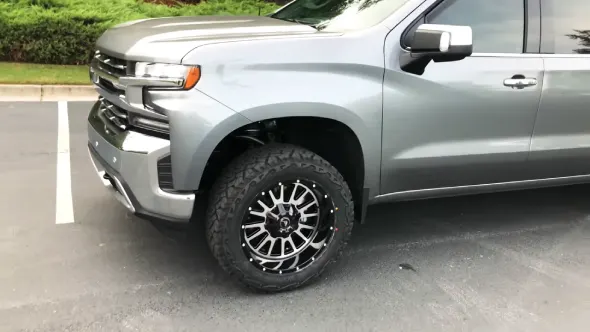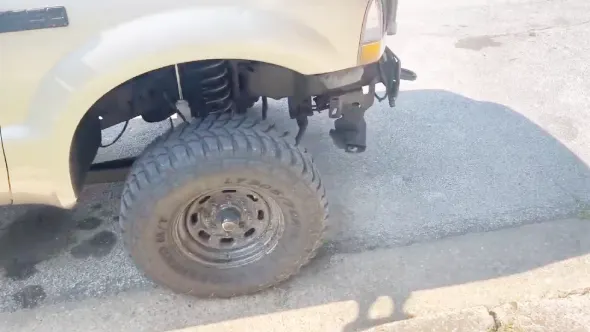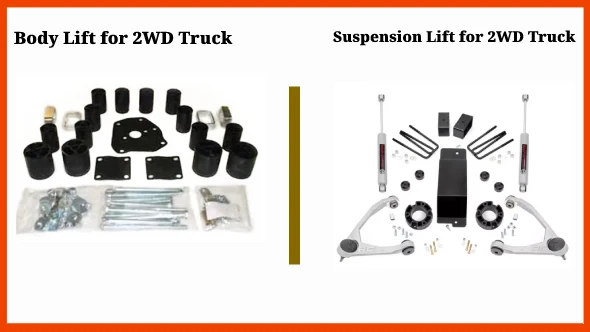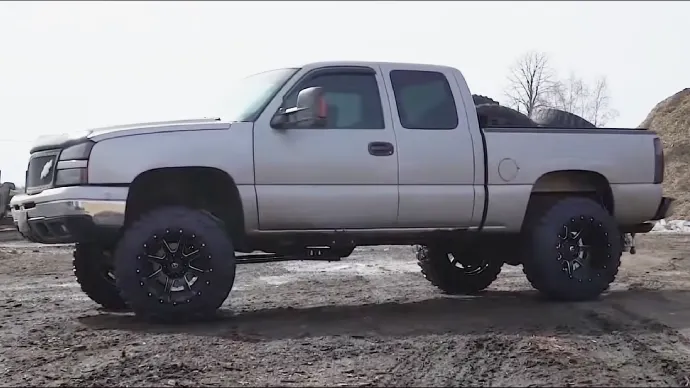Last Updated on May 7, 2023
Driving a lifted 2WD truck can give an instantly edgier presence on the road, but is it worth making that upgrade? Raising your ride with a lift kit gives improved ground clearance, an opportunity to install larger tires, and added style.
Some potential drawbacks come with lifting 2WD trucks, such as reduced MPG, handling and the potential for adverse reactions from others. It will potentially reduce towing performance.
When deciding whether to lift your 2WD truck, you must consider compatibility with existing components, local laws and regulations, intended use, terrain type, personal preferences, and budget.
Here we will take a deep dive into what it means to lift a 2WD so you make an informed choice that pleases both body and mind.
How High Should I Put A Lift Kit On My 2wd Truck: 4 Factors

When it comes to the question of how high to lift a 2WD truck, there is no one-size-fits-all answer. It is essential to consider various factors such as the intended use and terrain, personal preferences and budget, the impact on fuel economy, compatibility with existing components, and local laws.
Generally speaking, it’s recommended that a 2WD truck should be lifted no more than 6 inches above its original height. Then it can avoid any potential damage and maintain the vehicle’s center of gravity.
When adding a lift kit, it’s important to consider all the aspects that might be affected by the additional height, such as the axles and suspension components.
1. Intended Use and Terrain
The main factor in determining a 2WD truck’s lift height is its intended use and the type of terrain it will be driving on. If you plan to take your truck off-roading or through uneven terrains, a 4-6 inches higher lift would provide better ground clearance for navigating obstacles such as rocks, logs, or mud.
On the other hand, if your truck is mostly used for street driving, then a lower lift may be more appropriate because it can improve overall handling characteristics.
2. Personal Preferences and Budget
There are also personal preferences that may influence how high to lift a 2 wheel truck. For example, some drivers prefer having a higher stance, while others prioritize performance over aesthetics.
Depending on your budget constraints, you may need to adjust the height of the lift accordingly in order to ensure you don’t overspend or compromise safety or performance.
3. Compatibility with Existing Components
Ensuring compatibility with any existing components is important when selecting how high to lift your truck. Items such as shocks, springs, tie rods, and drag links are just some of the suspension and steering components that may be affected by the lift. They should be considered for their specific operational ranges.
Depending on the desired height of the lift, additional components such as body lifts or wheel spacers may need to be installed for the change to be compatible with all applicable parts.
Always consult an expert before attempting any modifications on your vehicle. You won’t damage it unknowingly or violate any warranty clauses associated with it.
4: Local Laws and Regulations
Before deciding on the lifting height of a truck, it’s essential that you take local laws into consideration as well. Many states limit the maximum height allowed for lifted vehicles for safety reasons.
A few states even mandate periodic inspections after certain heights are achieved. So it’s best to research any applicable laws beforehand in order to avoid facing legal repercussions later on down the line.
Benefits of Lifting A 2WD Truck

Lifting your 2WD truck can come with a variety of benefits, from improved off-road capabilities to a more customized appearance. Whether you want to hit the trails or just turn heads on the highway, lifting your 2WD truck can effectively get the job done.
1: Increased Ground Clearance for Off-road Driving
Lifting your two-wheel truck increases ground clearance, which can be invaluable when navigating challenging trails or other off-road environments. With greater clearance, you’ll be able to tackle obstacles like large rocks and gnarly logs without worrying about scraping the underside of your vehicle.
Depending on how much lift you install, you may even have enough room to add additional protective components, such as skid plates and brush guards, to improve off-road performance further.
2: Ability to Install Larger Tires for Better Traction
Another advantage of lifting your 2-wheel drive truck is that it allows you to fit larger tires. Larger tires provide better traction in all kinds of terrain, from mud on backcountry roads to sand on beaches.
Additionally, larger tires also give your vehicle an aggressive look that can set it apart from other vehicles on the road. Whether you’re looking for better performance or just a custom aesthetic, bigger tires are always a great option after lifting your 2WD truck.
3: Enhanced Road Presence
When lifted correctly, two-wheel drive trucks can have an imposing presence on the road, especially those with larger tires installed. The unique look of lifted trucks provides them stand out in any crowd and gives them a rugged edge over their stock counterparts.
If an eye-catching style is what you’re after, then lifting your two-wheel drive truck could be just what you need to take things up a notch.
4: Ability to Customize Your Vehicle
Lifting also provides drivers with ample opportunity for customization, from small touches like body panels and hood scoops up to full suspension lifts. It adds protection components like skid plates and bumpers.
With so many ways to modify your two-wheel drive truck’s exterior and interior aspects, there’s no limit to creating something truly unique that reflects who you are as an individual driver.
Drawbacks of Lifting A 2WD Truck

Lifting a two-wheel drive (2WD) truck can be a popular upgrade for many vehicle owners. However, it is important to consider the potential drawbacks before undertaking such an alteration.
1: Reduced MPG with Bigger Tires
One of the main cons of lifting a 2WD truck is decreased fuel economy due to installing larger tires. With bigger tires comes more rolling resistance which requires more fuel in order to keep the engine running at its optimal level.
Larger tires also increase aerodynamic drag when driving at highway speeds due to their increased size and profile. Since taller tires have a greater circumference than their smaller counterparts, they are less efficient at transferring power from the engine to the wheels.
As such, this can cause your vehicle’s fuel consumption to increase significantly over time.
2: Reduced Handling, Braking and Comfort
When you lift your 2WD truck, handling and braking performance will decrease due to its altered center of gravity. Raising the body creates a higher center of gravity for your vehicle’s body mass. It can cause it to roll more on turns or curves compared with an unmodified vehicle.
Larger tires may not be able to handle aggressive cornering as well as their smaller counterparts due to their increased rotational mass. Installing larger tires may reduce comfort by creating harsher ride quality than stock sizes due to their stiffer sidewalls.
3: Risk of Low Towing Performance
Raising your 2WD truck can negatively impact its ability to tow heavy loads. When lifting, your vehicle increases axle angles beyond factory settings. They can become over-stressed while handling heavy loads which can lead to premature wear or even failure when regularly used for hauling or towing applications.
If you are considering taking on heavy hauling or carrying sizable loads in your two wheel drive truck, consulting professionals for guidance is essential. This will help protect the integrity of your axles and ensure a safe journey.
4: Possible Negative Impact on Resale Value
When it comes to personalizing your truck with a body or suspension lift, you want experts on board who know the right installation techniques. Using these methods will ensure that not only are modifications completed properly but also preserve the resale value down the road.
High-quality standards must be met when choosing lift kits and accessories to guarantee your vehicle’s safety in the long haul.
5: Parts Wear Faster on Front Steering And Suspension
Installing a lift kit onto a 2WD truck while providing additional ground clearance can accelerate wear rates of the front steering and suspension parts. Parts such as ball joints and tie rods are put under more strain at higher angles than stock settings usually allow for safety.
It is necessary to inspect these components more frequently in order to detect signs of wear ahead of time. The necessary replacements can be made before any serious damage takes place. Ensure to get a proper alignment afterward in order to ensure that all the front-end parts remain within acceptable tolerance levels.
6: Potential Negative Reactions from Others
Assembling a lift kit onto a two-wheel drive truck can result in some negative reactions from those surrounding you. Although state laws vary with regard to these types of modifications, there are general regulations put in place to maintain public safety.
Thus, personal preferences should take second place when deciding to modify vehicles. This is because these alterations may present some risks if they are incorrect or done poorly.
What is a Better Body Lift or Suspension Lift for a 2WD Truck?

When considering a lift for your 2WD truck, it is important to understand the differences between body and suspension lifts. Body lifts are more budget-friendly while providing minimal ground clearance.
If you’re looking to take advantage of off-road capabilities, choosing a suspension lift would be advantageous as they offer greater articulation and improved stability. Be aware that added components may need installation when opting for this option.
How Much Does It Cost to Lift A 2WD Truck?
The cost of lifting a 2WD truck varies depending on the parts necessary for the installation, such as lift kits and additional hardware. Generally speaking, body lifts are cheaper than suspension lift kits, with installations typically costing around $200-$400 for basic kits.
Suspension lifts can cost significantly more often in the range of $1000-$3000 or more, depending on the kit and amount of additional hardware required.
Are Lifted 2WD Trucks Worse on Gas?
The amount of gas consumed by lifted trucks depends largely on their tire size. Larger tires can increase rolling resistance which causes engines to work harder and hence uses more fuel.
That said, some studies have suggested that the difference in fuel economy between lifted trucks with bigger tires compared to stock vehicles is minimal (1-2 MPG).
Is It Better to Lift or Drop A 2WD Truck: It’s Your Call
Whether or not you put a lift kit on your 2WD truck is up to you. But remember that careful consideration must be taken before making any decisions to ensure that you get the best experience possible out of your vehicle.
While there are potential benefits, such as improved ground clearance and the ability to customize with larger tires, there are drawbacks, such as reduced MPG and increased wear on parts due to the added strain from the leveling kit.
Thought should be given to intended use, terrain type and local laws, which may affect how high you can lift your 2WD truck and remain safe.
